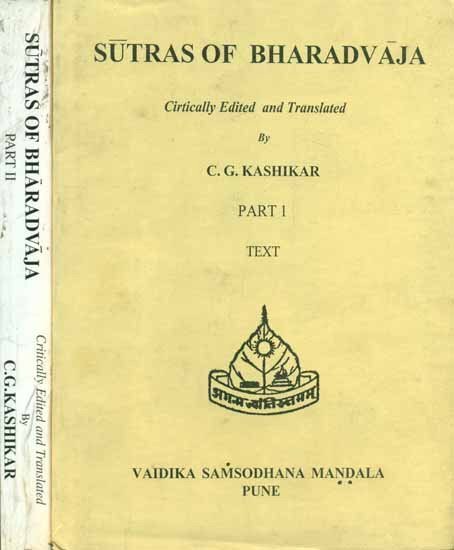Bharadvaja-srauta-sutra
by C. G. Kashikar | 1964 | 166,530 words
The English translation of the Bharadvaja-Srauta-Sutra, representing some of the oldest texts on Hindu rituals and rites of passages, dating to at least the 1st millennium BCE. The term Srautasutra refers to a class of Sanskrit Sutra literature dealing with ceremonies based on the Brahmana divisions of the Veda (Sruti). They include Vedic rituals r...
Praśna 12, Kaṇḍikā 21
1. At night they should carry the vasatīvarī water round the sacrificer and his wife who have seated themselves within the Mahāvedi.
2. One should not carry vasatīvarī water round one who is not consecrated.
3. The Adhvaryu should take up the pitcher of vasatīvarī water, place it on his left shoulder, go out (of the prāgvaṃśa) by the southern door, proceed along the southern boundary of the Mahāvedi, and then put it down near the southern buttock of the uttaravedi with the formula, “You are the portions of Indra-Agni.”[1]
4. He should again take up the pitcher, place it on his right shoulder, go by the same route by which he had gone, go put (of the prāgvaṃśa) by the northern door, proceed along the northern boundary of the Mahāvedi, and put it down on the northern buttock of the uttaravedi with the formula, “You are the portions of Mitra-Varuṇa.”[2]
5. He should again take up the pitcher, place it On his left shoulder, go by the same route by which he had gone, go out (of the prāgvaṃśa) by the eastern door, and put it down within the Āgnīdhra fire-chamber with the formula, “You are the portions of Viśve Devas; do you awaken in the sacrifice.”[3]
6. He should cause the pitcher of water to remain there.
7. The Subrahmaṇya should recite the subrahmaṇyā (formula)[4] containing the names of the fathers (= ancestors) and sons (= descendants.)
8. Then the Adhvaryu should give (the following) directions with regard to the milk: “Do you milk the sacrificer’s vrata-cow and keep that milk for mixing with Soma-juice; milk the vrata-cow of the sacrificer’s wife and keep that milk for Dadhigraha; milk the gharma-cow and keep that milk for Dadhigharma; use the hot milk, which has not been curdled, for the cup to Mitra-Varuṇa; use for the Āditya cup the milk which has been made hot and curdled.”
9. (The attendants) should act as directed.[5]
10. At this stage the Adhvaryu should cause the milk to be milked in the evening for the āmikṣā.
11. In the Havirdhāna[6] the sacrificer should be kept awake; the sacrificer’s wife in the prāgvaṃśa.
12. The officiating priests should remain in the Āgnīdhra fire-chamber. None of them should remain in the Sadas.
13. The sacrificer himself should guard king Soma during this night. So is it said.
Footnotes and references:
[1]:
Taittirīya-saṃhitā I.3.12.1.
[2]:
Taittirīya-saṃhitā I.3.12.1.
[3]:
Taittirīya-saṃhitā I.3.12.1.
[4]:
Āpastamba-śrauta-sūtra XI.21.8 prescribes the reciting of this formula after the Adhvaryu has given the directions in connection with the various milkings.
[5]:
[6]:
Or in the Āgnīdhra fire-chamber, according to Āpastamba-śrauta-sūtra XI.21.12.
